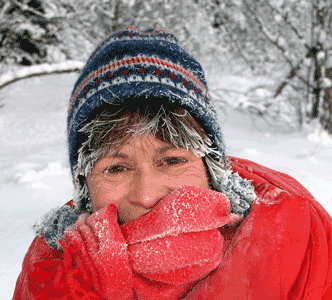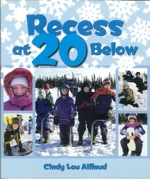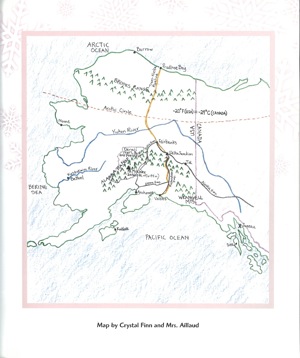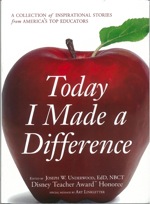There is a certain magic that happens in winter when the temperatures drop to colder than 20 below. When the thermometer shows 50 degrees BELOW zero, it’s really time for the fun to begin.
Children’s books are the cornerstone of many of Center for the Collaborative Classroom’s (CCC) programs; in a way, the authors are our behind-the-scenes collaborators. We want teachers, administrators, students, and parents to be able to learn more about these wonderful authors. We are happy to present the next in a series of author interviews, this one with Cindy Lou Aillaud. Her book Recess at 20 Below is used in our Being a Writer program. Ms. Aillaud has also contributed a short memoir (“Mission Possible”) to the anthology Today I Made a Difference: A Collection of Inspirational Stories from America’s Top Educators.
CCC: Sometimes, one of the hardest parts of the writing process is settling on a subject. The nonfiction Being a Writer lesson in which Recess at 20 Below is used features a quote by Grace Paley, We write about what we don’t know about what we know.
Our lives are so well known to us that we don’t always recognize their uniqueness. How did you decide to write a book about your “own backyard” (as you say)? What advice would you give to students searching for a topic?
Cindy Lou Aillaud: One year we had more kindergarteners than our elementary school could hold, so we moved my class to the middle school. I was the lone kindergarten classroom teacher; I was also the music, P.E., and recess teacher-and the lunch lady. On a very cold day in November, my kindergarteners were outside playing at recess while I stood shivering in my boots and wondering, “Why is it that I live here?” Suddenly I had an idea. I thought, “Oh my gosh, these Alaskan students have a story to tell and maybe I should help them tell it.” There aren’t many places in the world that kids play outside at 20 below.I advise students who are searching for a topic to write about something they know or are interested in. Look for small moments that can be expanded upon to build a wonderful story. You don’t have to travel to find a story. Just live life and pay attention to the experiences along the way.Sometimes it helps me to jot down topic ideas and add talking points for each one. Usually, one will pique my interest more than the others. Then it’s time to start writing!
CCC: In Recess at 20 Below you combine the very familiar (recess) with the less familiar (being outside at 20 degrees below zero). You bring a hard-to-imagine experience to life with great descriptions and sensory details (e.g., crunching snow sounding like potato chips, tongues sticking on cold metal, moist breath making frozen eyelashes). How do you create such vivid imagery?
Cindy Lou Aillaud: My best writing comes from events I experience. When I wanted to write about recess at 20 below, I went outside and played and I also talked with all the students in my school. I asked kids what it felt like to be outside during recess when it was so cold-what it sounded like, tasted like, looked like, even what it smelled like. Kids would write me notes and slip them under my P.E. office door. At the end of a teaching day I would find oodles of notes on the floor. I read every one of them and gathered a child’s perspective of recess at 20 below.
CCC: How did you prepare for the visual part of the project? How did the visual and written pieces of the book come together?
Cindy Lou Aillaud: Originally, Recess at 20 Below was a black and white photographic project. I love the look of black and white photos and I can develop the film and print images in my basement. It was a challenge to keep my camera and the film warm enough to function properly in such cold temperatures. Thank goodness I have a big parka!When I had taken hundreds of images, I began to see a storyline appear. It wasn’t until I presented my book idea to a publishing company, Northwest Books, that I started using color film. My initial story was all right but not engaging enough. One night when I was reading some of the kids’ notes about recess it suddenly made sense. I rewrote my story from a kid’s perspective and it worked! Then I was able to choose photographs to go with the story.
CCC: Writing can be a pretty solitary endeavor. In Being a Writer lessons, students share their work and offer each other feedback. The social interaction is an important part of the process. In what ways did you work on your early drafts and photographs with your editor and/or others?
Cindy Lou Aillaud: Many people helped me on this journey. Sharing my writing and photographs with others is very difficult for me. I feel like I am exposing my soul. When I share my personal views of a moment through a story and/or images, I open myself up for judgment and that’s hard for me to do. But it is the best way to learn about how one’s work is received and what can be done to improve it.I shared my work with kids and parents and with other authors and photographers. I treasured the students’ opinions of the mock-up of my book. My editor, Michelle McCann, and I had daily e-mail conversations about the book. At one point, I thought the story was ready but Michelle pushed me to rewrite it once AGAIN! I am ever so thankful she had confidence in what the book could be. My family was a sounding board through the entire process.
CCC: What did you learn from writing this book? What surprised you?
Cindy Lou Aillaud: I learned I can manage on very little sleep. When I worked on Recess at 20 Below, I was a full-time teacher with two sons, a husband, and a dog. My best successes happened sometime between 10 PM and 1 AM when everyone else was sleeping, because the house was quiet and I could think.I was surprised at how difficult it is to write, photograph, and publish a book that appeals to people of all ages. It took eight years from inspiration to completion.
CCC: Can you tell us a little bit more about the school and about daily life for kids in an extremely cold climate? What about the times of year when it is dark (or light) during most of a 24-hour day?
Cindy Lou Aillaud: There is a certain magic that happens in winter when the temperatures drop to colder than 20 below. When the thermometer shows 50 degrees BELOW zero, it’s really time for the fun to begin. Did you know that a banana can freeze hard enough to drive a nail into wood? That you can throw a cup of boiling water into the air and it vaporizes into a cloud of crystals while making a whoosh sound? That you can blow a soap bubble with a wand and the bubble will freeze like glass?During our coldest winter months, kids must be concerned about safety. They have to dress warm enough so as not to get frostbite. They also must be careful of wild animals all year long. Moose can be dangerous if they feel threatened and, of course, bears are a hazard-especially if you get between a mom and her cubs! In the summer, we have to be careful to get enough sleep. Since it is light all night, it’s easy to stay up too late!
CCC: You seem to throw yourself into new experiences (your move to a remote part of Alaska, leaping into writing the book, studying photography, etc.). Where do you think this inclination originates? Can you tell us about other adventures in your life?
 Cindy Lou Aillaud: I grew up in an era when kids were allowed more freedom to go outside and play. My siblings and I spent every free minute exploring the surrounding area and solving problems with the neighborhood kids. My parents allowed us the opportunity to be independent and daring. I think this greatly contributed to my desire to seek out new experiences and adventures.Both my husband and I find the world and its people fascinating. Our first Alaskan teaching assignment was in an Athabascan village north of the Arctic Circle. The only way to get there was to fly in on a small aircraft. We had to bring one year’s supply of food, since there were no stores and the mail plane was infrequent. During that year, I was not only a teacher but also a student of a new culture and a different way of living. I have traveled the world and marveled at humpback whales and the Himalayas, the Taj Mahal and the Incan Ruins, and I have also visited schools far and wide and been wowed by the universal eagerness of children to learn.
Cindy Lou Aillaud: I grew up in an era when kids were allowed more freedom to go outside and play. My siblings and I spent every free minute exploring the surrounding area and solving problems with the neighborhood kids. My parents allowed us the opportunity to be independent and daring. I think this greatly contributed to my desire to seek out new experiences and adventures.Both my husband and I find the world and its people fascinating. Our first Alaskan teaching assignment was in an Athabascan village north of the Arctic Circle. The only way to get there was to fly in on a small aircraft. We had to bring one year’s supply of food, since there were no stores and the mail plane was infrequent. During that year, I was not only a teacher but also a student of a new culture and a different way of living. I have traveled the world and marveled at humpback whales and the Himalayas, the Taj Mahal and the Incan Ruins, and I have also visited schools far and wide and been wowed by the universal eagerness of children to learn.
CCC: In the schools you visit, what have you found that is similar to your little school in Alaska and what is different?
Cindy Lou Aillaud: First of all, kids everywhere like to build forts: snow forts, tree forts, underground forts, and even under-the-kitchen-table forts. Many kids spend their recesses working on a fort with their friends. I guess everybody needs his or her own spot.In all the schools I visit, from Alaska to Massachusetts to Mexico and Germany, the kids are friendly and interested in the stories I share. I have seen classrooms open to the elements and without electricity, overflowing with impoverished children who all are curious about their world. I think that is the nature of kids.The differences I observe are mostly related to weather and the type of school building. Some schools in the southwest don’t even have a gym because the weather is so warm all year. Those kids have to dress differently for recess when it’s 100 degrees ABOVE zero!
CCC: Outdoor play and physical activity have been very important in your life and career. These days children’s play is more sedentary than it used to be, and at the same time many school administrators either choose or feel pressured to focus on academics to the exclusion of P.E. (and art). Can you comment on the link between physical activity and academic success?
Cindy Lou Aillaud: The two go hand in hand. Research indicates that children who have regular physical activity have increased attention spans and greater success on academic achievement tests. Encouraging families to participate in physical activity with their kids after school fosters life-long good fitness habits. Healthy kids have healthier futures. With the obesity crisis affecting our nation we must advocate for increased physical activity in our schools through physical education programs, recess, and activity breaks in the classroom.
CCC: In “Mission Possible,” your contribution to the Today I Made a Difference anthology, you tell a story about a wheel-chair-bound Russian-speaking student with cerebral palsy who was integrated into your remote Alaskan school and into your P.E. class. You embraced the challenge, approaching David as someone both with unique disabilities and the same responsibilities and needs as everyone else. What did the students learn from your ready acceptance of him in your class?
Cindy Lou Aillaud: David taught us that we all have more similarities than differences. We all have wants, needs, and dreams. I am hoping that in the future my students won’t be afraid to include someone who is physically challenged, such as David.
CCC: At Collaborative Classroom, we try to use children’s literature that depicts many kinds of people, families, and settings. The kids in northern Alaska probably don’t often see their daily lives depicted realistically in stories. In your travels to schools across the country, do you meet many students whose lives are rarely represented in books? If so, who are they and how do you think this affects their ideas about writing?
Cindy Lou Aillaud: Everyone has a story to tell. If that story hasn’t been written yet, that is the story that needs to be told.I once visited a school on a day after a foot or more of snow had fallen. I was puzzled as to why the hills in the area weren’t full of footprints and sledding tracks. When I learned that the neighborhood isn’t safe to play in after school due to gang-related activity, it made me very sad. The only time most of these kids play outside is during recess with a great deal of supervision and security. To these students that is normal. I’m not sure how many books have been written addressing the life these children are living. I hope that someday one of them might write their own book about their experiences growing up in that environment.
